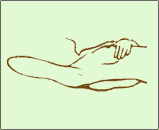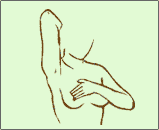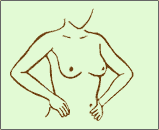|
Breast Self-Exam
Beginning by the age of 20, monthly breast self-exams should be performed by all women. (See How to Perform a Breast Self-Exam instructions below.) By performing regular breast exams, a woman will be more familiar with the way their breasts normally look and feel. With this awareness, women are more likely to notice any changes which occur, i.e. masses, lumps, discoloration, or discharge. The most optimal time to do a breast self-exam is one week following the conclusion of your monthly period. At this time, breasts will not be tender or swollen. For women who no longer have a period, an exam done on the same day of each month is recommended. If any change is detected during a breast self-exam, see your healthcare provider right away. While breast self-exams are one of the most effective means for early detection of breast cancer, in the majority of cases, breast changes are not a sign of cancer. Only your doctor can make the correct diagnosis concerning changes which have occurred.
In addition to breast self-exams, women should have a clinical breast exam once a year. Starting at the age of 40, women should have annual screening mammograms. Women under age 40 with a family history of breast cancer and other concerns about their personal risk should consult with a health care provider about risk assessment and when to begin screening mammography.
HOW TO DO A BREAST SELF-EXAM
Breast self-exams should be performed monthly in three ways...(1) lying down; (2) standing up; and (3) in front of a mirror.

(1) Lying down - Place a small pillow under your shoulder blades. Place your right arm above and behind your head. Use your left hand, middle three fingers, to examine the right breast. Begin with light touch and increase to a more firm touch to feel deeper tissues. Go over the entire area of the right breast including the armpit. Use a specific pattern to cover the area (either circular, up-and-down, or wedge pattern). Use the same pattern every month. Repeat on the other side, placing the left arm above and behind the head and examining with the right hand over the left breast area including the armpit.

(2) Standing up - Women often prefer to do the standing exam in the shower. Place your right arm above and behind your head. Use your left hand, middle three fingers, to examine the right breast. Begin with light touch and increase to a more firm touch to feel deeper tissues. Go over the entire area of the right breast including the armpit. Use a specific pattern to cover the area (either circular, up-and-down, or wedge pattern). Use the same pattern every month. Repeat on the other side, placing the left arm above and behind the head and examining with the right hand over the left breast area including the armpit.

(3) Mirror exam - In front of a mirror, inspect your breasts with your arms at your sides, with your hands on your hips flexing your chest muscles, with your arms over your head, and bending forward with your hands on your hips. Examine from the front and each side. Examine for discoloration, puckering or pulling of the skin, inversion of the nipples, swelling, or difference in size (normal breasts are often different in size). Examine each nipple for any skin scaling. Squeeze each nipple to determine if any discharge is present. Report any discharge immediately to your physician.
Click for FREE Breast Self-Exam Instructions and Chart
 |

